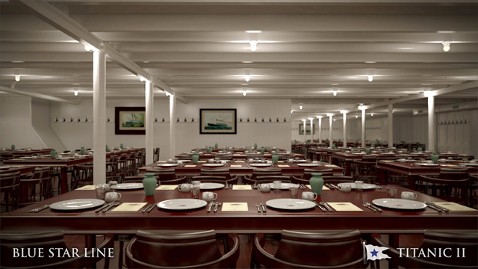Titanic II Interior Plans Revealed
An Australian billionaire has released blueprints for the Titanic II, with plans to set sail across the Atlantic in 2016.

Blue Star Line/AP Photo
Real estate and coal magnate Clive Palmer announced his plans at the Intrepid Sea, Air and Space Museum in New York on Tuesday. He said the replica will look and feel like the original Titanic. Some people may be uneasy about the idea, but Palmer said others are clearly fascinated by the Titanic's story.
"The area [for] passengers will be authentic, with the same design and facilities. But there will be modern things such as air conditioning and other features we are debating - such as Internet on the ship," Palmer said at a press conference.

Blue Star Line/AP Photo
The ship will be built in China. Crew members' outfits will be inspired by the styles of 1912. There will be dishes from the original menu for passengers to enjoy, Palmer said.
The Titanic II will carry 2,600 passenger and 900 crew members. There will be enough lifeboat space for all of them.
And to give passengers a true Titanic experience, there will be three passenger classes, just as there were on the original ship in 1912. Palmer said those in first class will be kept apart from anyone in second or third class.
"There won't be TVs in the staterooms, though," Palmer said.

Blue Star Line/AP Photo
Palmer said 40,000 people have expressed interest in tickets on the ship, which will sail the original course from Southampton, England, to New York.
When asked about the original ship sinking and what makes his design different, Palmer said, "Anything will sink if you put a hole in it. I think it would be very cavalier to say it. I think people in the past have done that and lived to regret it."
Palmer, a mining tycoon estimated to be worth $5.2 billion according to BRW magazine, wouldn't announce ticket prices, but said prospective passengers are offering up to $1 million to get on board.
Palmer called the project "a tribute to the spirit of the men and women who worked on the original Titanic."
The original Titanic, which sank in April 1912 after hitting an iceberg, has become one of the most enduring tragedies of the 20th century. Some 1,500 people died when it went down; only 700 were saved.

Blue Star Line/AP Photo